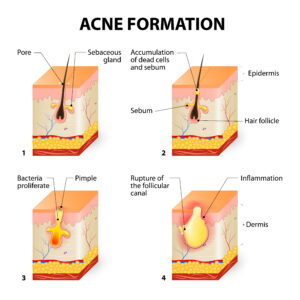
Most people think of acne as pimples, but in reality, it’s a bit more complicated than angry red spots on your face or body. Acne occurs when the pores on the face or body become clogged with oil, dead skin cells, and, in some cases, bacteria.
Pimples may be the most well-known form of acne, but it can also show up as blackheads, whiteheads, or deep and painful cysts. Trying to cover it up with makeup can irritate your face and actually make the acne worse.
How Common is Acne?
Acne is one of the most common skin conditions in America, and one that we see every day at Pariser Dermatology. According to the American Academy of Dermatology, around 50 million Americans are treated for acne every year. Additionally, 85% of people between the ages of 12 and 24 will experience at least one breakout at some point.
However, teens aren’t the only ones who get acne; adult acne is more common than most people realize because a number of products and hormonal changes can result in clogged pores. In fact, over 50% of people over the age of 20 will experience acne at some point in adulthood, with women significantly more likely to have persistent acne compared to men.
Types of Acne
Acne is more than just a red pimple that sits on your face, irritating you until the day it pops. It actually comes in several forms, each with its own causes and treatment considerations. There are three main types of acne. Understanding the differences is key to effective care.
- Comedonal: The first is comedonal acne, which includes blackheads and whiteheads and presents as small clusters of bumps that are notably smaller than traditional pimples but still disruptive enough to warrant action.
- Inflammatory: This is the type that is immediately recognizable to most people in their youth and is characterized by red, swollen pimples that appear to be full of liquid. These are often tied to hormonal changes, but have a myriad of other causes as well.
- Cystic: This acne type is one of the hardest to treat. It is characterized by large, painful lumps that sit beneath the skin’s surface.
Common Causes of Acne

Acne isn’t just a teen problem—while hormonal changes during puberty, menstruation, or pregnancy can trigger breakouts, many other factors contribute to adult acne, making it a common and persistent skin concern for people of all ages. Excess oil production can clog pores and cause breakouts if the skin is not properly cleansed. Daily skincare essential for clear, healthy skin.
Bacteria that live on the skin can also lead to clogged pores, as well as certain medications that alter the balance of your skin. Not all cosmetics are dermatologically friendly, so if you have issues with acne, it’s important to look for mineral-based makeup that is non-toxic.
Additionally, stress and diet may also play a role in the development of acne in those who are genetically predisposed to it. It is a known fact that certain types of acne are linked to genetic factors. While there is no one gene yet identified as the “acne gene,” the presence or absence of certain genes may explain why families may see an increase in acne susceptibility that is linked from parents to children.
Certain hormonal conditions, such as PCOS, often cluster in families and frequently link to acne.
Why Early Treatment is Important
Untreated acne can lead to scarring and dark spots, which are often harder to correct later on. Addressing acne early not only helps prevent these long-term skin issues but can also help boost self-esteem and confidence. Clearer skin can positively impact many areas of your life, from social interactions to professional situations.
On top of that, early treatment can reduce the risk of persistent or chronic acne in the future, making it easier to maintain healthy, blemish-free skin over time.
Effective Treatments at Pariser Dermatology
At Pariser Dermatology, we offer a variety of effective treatments geared toward providing the best results for every patient based on their individual skin profile.
Our treatments include:
- Topical Medications: Creams and gels that contain acne-fighting ingredients such as benzoyl peroxide, salicylic acid, or retinoids can target pimples and prevent new ones from forming.
- Oral Medications: Antibiotics or hormonal treatments for more severe cases of persistent acne. Isotretinoin is used to treat a certain type of severe (nodular acne) that has not responded to other treatments.
- Chemical Peels: Used to exfoliate skin and reduce the presence of acne lesions, and promote smoother skin.
- Laser Therapy: Targets sebaceous glands to reduce overall oil production and reduce breakouts.
- Extraction Procedures: The professional removal of blackheads and whiteheads to improve skin texture and prevent further irritation.
What to Expect From Your Treatment
Treatments are not instantaneous, as the skin has to heal before it can become blemish-free. Most patients see initial improvement within 4-6 weeks, but more serious cases may take longer to resolve.
The key to effective treatment is to follow all recommendations consistently, both in and outside of the office. Some cases may require maintenance treatments in order to keep acne under control. Your dermatologist will create a customized plan for you that they will discuss in detail before you leave the office.
Tips for Managing Acne at Home
While not all acne will respond to home treatments, there are a few things everyone can do to help prevent it.
- Cleanse your face gently daily with a non-toxic facial cleanser
- Use non-comedogenic skincare and makeup products to avoid clogging your pores
- Avoid touching your face frequently to reduce the spread of bacteria
- Use relaxation techniques to help manage stress-related breakouts
- Stick to your dermatologist’s recommended routine and avoid skipping treatments
When to Consult With a Dermatologist
Not every breakout requires a trip to the dermatologist. If your acne isn’t responding to over-the-counter products after six to eight weeks, it is time to talk to a professional.
Additionally, if acne is causing emotional distress or leaving scars behind, it’s time to consult with a dermatologist. A dermatologist can assess your skin, identify underlying causes, and develop a personalized treatment plan to help you achieve clearer, healthier skin.
Why Choose Pariser Dermatology
Pariser Dermatology’s experienced, board-certified dermatologists are experts at treating acne. Our clinical staff will sit down with you and learn about your lifestyle and skin type. Then they will create a personalized treatment plan with a comprehensive range of treatments.
Outcome
Waiting for acne to clear on its own can be frustrating. Without treatment, it can cause permanent scars, low self-esteem, depression, and anxiety. To avoid these possible outcomes, dermatologists recommend treating acne. When the skin clears, treatment should continue. Treatment prevents new breakouts. Your dermatologist can tell you when you no longer need to treat acne to prevent breakouts.
To book your appointment with one of our medical providers, call us at 757-622-6315 or click here to request an appointment online.



